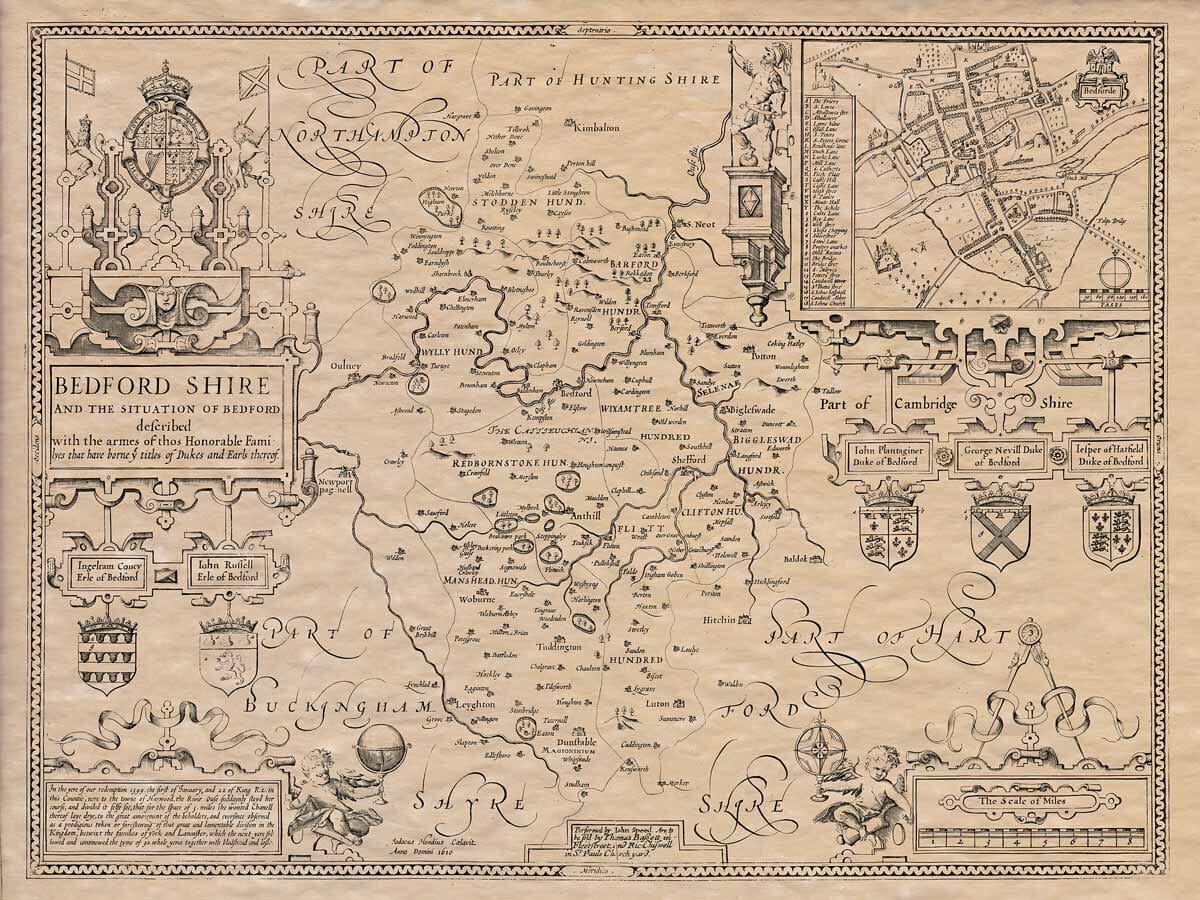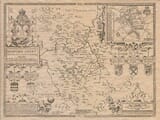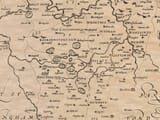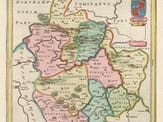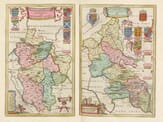Description
John Speed added a notes to the rear (the verso) of his old maps, Below is a translation into modern English which makes an interesting historical snapshot of
BEDFORDSHIRE in the 1600’s
The Description of BEDFORD-SHIRE
(CHAPTER XXI in the atlas.)
(1) Bedford-shire, located in the southeast of this island, is a plain and open (champion) country. It is bordered:
On the north by Huntington-shire On the east by Cambridge and Hertford shires On the south by Hertford and Buckingham-shires On the west by Buckingham and Northampton-shires
(2) The shape of the county is somewhat oval and not very large: from Tilbrook in the north to Studham in the south is about 20 English miles; and from Turvey in the west to Hatley Cocking in the east, it’s about 14 miles — making the circumference roughly 70 miles.

(3) The air is temperate, and the soil bountiful — especially in the north, where the River Ouse flows through many winding paths.
The south is more barren and produces less, but it still yields good barley, which isn’t easily surpassed elsewhere. Generally, this county is fertile and fruitful, though some places are sprinkled with pasture and woods.
(4) The ancient inhabitants, known to the Romans, that lived in this shire were part of the Cattieuchlani, a strong and warlike tribe. Later they came under Roman control when Caesar brought Britain into a Roman province. His legions stationed at Salena and Magintum — now Sandy and Dunstable, notable Roman sites in the county.
Afterwards, when the Saxons sought to reclaim the land, they took it from the Britons under Cuthwulf, a West-Saxon leader, around the year 572, and the Mercians later held it as part of their kingdom.
(5) In the year 1399, during the wars between the Princes of Lancaster and York, the River Ouse near Newport Pagnell suddenly dried up and wouldn’t flow further — revealing the very depth of its channel. Afterward, it returned as strongly as ever, which was seen as a sign of future political upheaval.
(6) The county suffered heavily during the Danish invasions. The Danes occupied the area. During King Stephen’s reign, the town and castle were seized by Empress Maud, and much blood was shed. In King John’s time, the people rebelled, and later King Henry III destroyed the castle entirely.
(7) The town of Bedford, the county capital, was once called Lettidur by the Britains and Bedford by the Saxons. It is the most important town in the county, named after the River Ouse and pleasantly located. A stone bridge crosses the river in the middle of town. There are two gates to lock it, which could stop traffic in times of trouble.
Notable places include:
St. Leonard’s Hospital for Lazars
Churches of St. John and St. Mary
The town’s parish churches: St. Cuthbert, St. Peter, St. Loyes, Allhallows, and Cardinal’s Abbey
Former Chapel of King Offa, where his body was supposedly buried after being swept away by the river. A piece of lead (said to be his tomb) was once found, though others say it was not his.
(8) Dunstable has a tale of a robber named Dun, punished by King Henry I, but it is more likely that it was a Roman town, as it had Roman legions. A nearby village is still called Maiden-mongery, showing the Roman influence.
(9) Important castles in the shire include:
Woodhill, Eaton. Tempsford and Ampthill
Ampthill was once held by the Crown, and many relics and devotions were offered there. These were destroyed during King Henry VIII’s reign when many shrines were demolished.
(10) Geography:
The town of Bedford lies 52 degrees and 30 minutes north latitude, and about 16 minutes west of the Prime Meridian.
(11) Notable noble families bear the titles of Dukes and Earls. The shire is divided into nine Hundreds (districts), with seven Market Towns and 156 parish churches.
————————————————————————————————————

